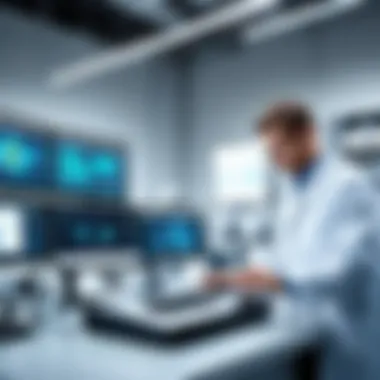Exploring LIMS System Examples for Diverse Industries


Intro
Laboratory Information Management Systems (LIMS) play a crucial role in modern laboratory management. As laboratories increasingly adopt technology to manage their workflows, LIMS becomes integral for maintaining efficiency and compliance. This overview is aimed at decision-makers and industry professionals who seek detailed insight into various LIMS solutions available today.
In this article, we will explore numerous examples of LIMS, dissecting their functionalities and applications across diverse fields. The conversation will cover essential features that enhance lab operations, including data management, sample tracking, and regulatory compliance. With a detailed understanding of these systems, stakeholders can make informed decisions that align with their operational needs.
Key Software Features
Essential functionalities
When evaluating LIMS systems, certain core functionalities consistently stand out. These include:
- Sample Tracking: Efficient tracking of samples from initial collection to final results.
- Data Management: Robust data storage and organization capabilities for easy access and retrieval.
- Workflow Automation: Automating mundane tasks to free up researchers for more critical activities.
- Regulatory Compliance: Ensuring adherence to strict standards, especially in pharmaceuticals and clinical labs.
These features are designed to improve the overall efficiency of laboratory processes and facilitate better decision-making.
Advanced capabilities
Beyond the basic functions, advanced capabilities further differentiate LIMS products. These may include:
- Integration with Other Systems: Seamless integration with ERP or ELN systems to create a comprehensive lab environment.
- Real-Time Data Analysis: Tools for real-time monitoring and analysis to adapt quickly to changing conditions.
- Mobile Access: Providing laboratory staff with access to critical information on-the-go, increasing flexibility.
- Custom Reporting: Allowing users to create tailored reports that meet specific regulatory or operational needs.
Together, these advanced features provide laboratories with the tools necessary to navigate the complexities of modern scientific research and regulatory landscapes.
"A well-implemented LIMS can transform laboratory processes, making them faster, more reliable, and compliant."
Comparison Metrics
Cost analysis
Cost is often a decisive factor when selecting a LIMS solution. Costs can include:
- Licensing Fees: Ongoing fees for software usage, which can vary significantly based on functionality.
- Implementation Costs: The expenses associated with deploying the LIMS, including training and system integrations.
- Maintenance Fees: Regular costs to ensure the system continues running smoothly and securely.
Understanding these costs in detail aids decision-makers in budgeting and evaluating return on investment.
Performance benchmarks
Evaluating performance benchmarks helps in comparing LIMS systems effectively. Relevant metrics include:
- User Satisfaction: Measured through surveys or case studies from other labs.
- System Up-time: The reliability of the system during routine operation.
- Data Integrity: The accuracy and consistency of data stored within the system.
Collectively, these benchmarks provide a clearer picture of a system's efficiency and effectiveness in a real-world setting.
\nThis article serves as a comprehensive guide for understanding the evolving landscape of Laboratory Information Management Systems. By exploring specific examples, we highlight their diverse applications and features, enabling informed decisions in the complex domain of laboratory management.
Prelude to LIMS Systems
Laboratory Information Management Systems, or LIMS, serve as critical frameworks within the modern laboratory environment. The need for efficient data management, regulatory compliance, and streamlined workflows has never been more pressing, especially as laboratories face increasing volumes of data and stringent regulations. In this context, LIMS systems emerge not only as tools but as essential components that enhance productivity and accuracy in laboratory operations.
Defining Laboratory Information Management Systems
Laboratory Information Management Systems can be defined as software-based solutions designed to streamline lab processes, manage samples, and handle laboratory data. These systems can facilitate tracking of samples from the point of collection to the point of analysis and reporting. Key features of LIMS include sample management, data management capabilities, user access controls, and integration abilities with laboratory instruments. By integrating these features, LIMS enhances the ability to maintain data integrity, ensuring that laboratory professionals can access accurate and up-to-date information whenever necessary.
Importance of LIMS in Modern Laboratories
LIMS play a pivotal role in modern laboratories across various sectors. Their significance lies in several key areas:
- Data Management and Compliance: Maintaining accurate data is vital for meeting regulatory standards. LIMS systems help ensure data integrity and facilitate compliance with regulations from agencies such as the FDA or EPA.
- Efficiency Enhancement: By automating repetitive tasks and improving data access, LIMS reduce the time spent on manual processes, allowing laboratory personnel to focus on more critical tasks that require their expertise.
- Support for Decision-Making: With built-in analytics tools, LIMS offer advanced reporting that enables laboratory managers to make informed decisions based on real-time data analysis.
In summary, LIMS are crucial in today’s laboratories, shaping how data is collected, processed, and reported. The ability of these systems to adapt to various laboratory needs ensures their continued relevance and importance across industries.


"LIMS are not just tools; they are integral partners in modern laboratory operations."
Through understanding the fundamentals and the vital role that LIMS systems play, laboratory managers and stakeholders can better appreciate the potential these systems hold for optimizing laboratory functions.
Key Features of LIMS Systems
Laboratory Information Management Systems (LIMS) possess several key features that significantly enhance laboratory operations. Understanding these features is essential for decision-makers looking to implement or upgrade a LIMS solution. The functionalities offered by various LIMS systems contribute to data management, workflow efficiency, integration capabilities, and reporting insights. Investing time in examining these features assures that laboratories can fully leverage their data, streamline operations, and maintain compliance with industry standards.
Data Management Capabilities
Data management is at the core of any effective LIMS. These systems provide robust solutions for the organization, storage, and retrieval of vast amounts of laboratory data. Users can input and access data in real time, which minimizes the risk of errors often associated with manual entry. Key elements include:
- Centralized data repository: All data is stored in one location, making it easier to manage and access.
- Automated data capture: Linking LIMS directly to laboratory instruments allows for automatic data collection, thereby reducing manual input and potential errors.
- Version control: LIMS typically includes versioning features, ensuring all data revisions are trackable.
These capabilities enable efficient management of samples, tests, and results, essential for ensuring accurate and compliant laboratory operations.
Automation and Workflow Management
Automation within LIMS systems optimizes workflow processes. By automating repetitive tasks, such as sample tracking and reporting, laboratories can save time and allocate resources more effectively. Essential aspects of automation include:
- Sample tracking: LIMS automates the entire lifecycle of a sample, from receipt to analysis and disposal.
- Task assignments: Automatic workflow assignment to laboratory personnel helps in maintaining accountability and progress.
- Alert notifications: LIMS systems can send alerts for critical updates or deadlines, ensuring timely actions are taken.
Implementing such features enhances productivity and reduces the likelihood of human error, leading to more reliable results.
Integration with Laboratory Instruments
The ability to integrate with various laboratory instruments is a vital feature of a LIMS. This connectivity ensures that data flows seamlessly between instruments and the LIMS, enhancing both accuracy and efficiency. Key points include:
- Real-time data transfer: Integration allows for immediate data upload from instruments to the LIMS.
- Reduced manual entry: Simplifying data input helps prevent errors and accelerates data processing.
- Support for diverse instruments: A comprehensive LIMS can work with multiple types of instruments used across various laboratory environments.
Effective integration means that laboratories can rely on accurate data while achieving less time lost on manual data transfers.
Reporting and Analytics Features
Reporting and analytics are crucial for deriving insights from laboratory data. A good LIMS offers extensive reporting capabilities that assist laboratories in meeting regulatory requirements and improving operational efficiency. Noteworthy reporting features include:
- Customizable report generation: Users can create tailored reports suited to their specific needs and regulatory standards.
- Real-time analytics: Access to real-time data analytics enables quick decision-making.
- Compliance tracking: Reporting tools help to ensure that all necessary compliance is documented and readily available for audits.
These reporting features not only ensure compliance but also enhance the laboratory's ability to analyze trends.
The ongoing evolution of LIMS technology emphasizes the importance of choosing a system that meets the specific needs of your laboratory, facilitating better data handling and operational excellence.
Examples of LIMS in Specific Industries
Laboratory Information Management Systems (LIMS) play a crucial role across various industries. Their implementation streamlines data management and enhances laboratory efficiency. Different sectors utilize LIMS tailored to their unique needs and regulatory requirements. By examining specific examples, we can grasp how LIMS contributes to operational excellence.
Clinical Laboratory LIMS Examples
In the realm of clinical laboratories, LIMS is deployed for patient sample management and clinical data analysis. It facilitates tracking of samples, automating workflows, and managing results reporting. Key benefits include reduced turnaround times and improved traceability, which are vital in healthcare settings. Systems like LabWare and Sunquest have gained popularity for their comprehensive features designed specifically for clinical environments. They ensure that labs comply with stringent regulations while safeguarding patient data privacy.
Pharmaceutical Industry LIMS Applications
LIMS in the pharmaceutical industry aids in research and development, quality control, and ensuring compliance with regulations such as FDA requirements. The ability to manage large volumes of complex data is crucial in this field. Solutions like STARLIMS are used to handle laboratory data, streamline clinical trials, and support regulatory submissions. These systems help maintain good laboratory practices (GLP) and can integrate with other systems to provide a holistic view of data management across drug development stages.
Environmental Testing LIMS Solutions
Environmental laboratories leverage LIMS for managing samples from various sources such as soil, water, and air. These systems are essential for tracking samples, ensuring compliance with environmental regulations, and reporting results. For instance, Thermo Fischer offers solutions that help laboratories efficiently manage data regarding contaminants. By using LIMS, environmental labs can enhance their analytical capabilities, improve quality assurance, and provide timely reporting for regulatory compliance.
Food Safety and Quality Control LIMS
In the food and beverage industry, LIMS significantly contributes to maintaining safety and quality standards. These systems track raw materials, manage laboratory testing, and ensure compliance with health regulations. Solutions like SYSTECH promote efficient data management throughout the supply chain. The integration of LIMS within food safety protocols aids in identifying risks, ensuring traceability, and facilitating rapid response in cases of potential contamination.
Academic and Research Laboratory LIMS Examples


Academic and research institutions utilize LIMS to manage research data effectively. These systems provide support in project management, experiment tracking, and collaboration among researchers. Examples such as LabCollector demonstrate their capability in facilitating multi-user access to data. This promotes transparency and enhances collaboration in research projects while ensuring that laboratories achieve required compliance with grant-funded research regulations.
Comparison of Popular LIMS Solutions
The evaluation of Laboratory Information Management Systems (LIMS) is crucial for laboratories seeking to optimize operations. A proper comparison helps decision-makers understand the spectrum of solutions available in the market. This section elaborates on comparative elements that catalyze informed decision-making regarding LIMS systems.
To ensure a practical approach, understanding the unique features, costs, and support options of several leading systems is essential. Each LIMS solution offers distinct benefits and challenges that can align or misalign with the specific requirements of a laboratory. Decision-makers must consider factors such as scalability, ease of use, and integration with existing systems. A precise understanding of these aspects leads to better resource allocation and operational efficiency.
Commercial vs. Open Source LIMS
The distinction between commercial and open-source LIMS is significant. Commercial LIMS solutions often provide robust support and comprehensive features. Vendors like Thermo Fisher and LabWare, for instance, offer platforms with end-to-end functionalities tailored to meet diverse laboratory needs. These solutions may include customer support, training, and regular updates, which are crucial for maintaining system performance.
Conversely, open-source LIMS such as OpenLIMS or LabKey provide flexibility and customization options. They cater to laboratories with specific needs or those with technical expertise. While open-source systems can reduce initial costs, they may lack the support infrastructure of commercial options. Organizations willing to invest time in customization may find significant advantages in terms of adaptability and cost-efficiency.
Cloud-Based LIMS vs. On-Premises Solutions
The debate between cloud-based and on-premises LIMS solutions centers on flexibility and control. Cloud-based systems, such as LabArchives and STARLIMS, deliver accessible platforms that support remote work and collaboration. These solutions often require less upfront investment, as ongoing costs are subscription-based. The scalability of cloud solutions allows laboratories to adapt to changing demands without overcommitting resources initially.
On-premises LIMS like LabWare and SoftMax Pro offers greater data control and security. This setup can be critical for organizations that manage sensitive data. However, on-premises solutions come with higher upfront costs and may necessitate IT infrastructure investment. Also, maintenance and updates usually burden the laboratory's internal resources. A careful assessment of security needs and operational workflows will guide the choice between these two deployment methods.
Feature Set Comparison of Leading LIMS Vendors
When reviewing leading LIMS vendors, a thorough feature-set comparison is essential. Different vendors offer various functionalities that can dramatically impact laboratory performance. For example:
- Thermo Fisher: Known for its extensive integration capabilities with laboratory instruments and comprehensive reporting tools.
- LabWare: Offers high customization and a wide array of applications tailored to specific industries.
- STARLIMS: Features robust analytics and data visualization options, which can enhance decision-making processes.
Summary
In summary, a well-rounded understanding of the differences between commercial versus open-source options, cloud versus on-premises solutions, and the diverse features of leading vendors empowers decision-makers. By recognizing which attributes align best with their laboratory needs, professionals can shape an efficient, cost-effective approach to implementing LIMS.
Selecting the Right LIMS for Your Laboratory
Selecting the right Laboratory Information Management System is a crucial step for laboratories aiming to optimize workflow and compliance. The choice of a LIMS can significantly impact data management and operational efficiency. As laboratories face an increasing volume of data, having a reliable system to manage this data is essential. This section emphasizes the need for a careful selection process to ensure that the chosen system aligns with specific laboratory requirements.
Identifying Laboratory Needs
Understanding the unique needs of your laboratory is the first step in selecting a LIMS. Each lab operates under different conditions and with various types of samples, therefore, the features required in a LIMS can also differ widely. Key areas to assess include:
- Sample types you handle: biological samples may require stringent control, while environmental samples might focus on tracking physical variables.
- Laboratory processes: workflow efficiency can vary. Evaluate if your lab requires specific modules for sample tracking, inventory management, or data analysis.
- Compliance requirements: it is vital to consider any regulatory standards you must meet, such as HIPAA in clinical labs or GLP in research labs. LIMS can help ensure adherence to these regulations by providing audit trails and documentation support.
Carefully analyzing these needs will help lay a foundation for the evaluation of different LIMS options.
Criteria for LIMS Evaluation
Once laboratory needs are identified, the next step is evaluating the potential systems against these requirements. A systematic approach to assessment can make the decision clearer. Important criteria may include:
- User interface: The system should deliver an intuitive user experience, minimizing the training time required for staff.
- Integration capabilities: Choose a LIMS that integrates seamlessly with existing laboratory instruments and software. This avoids data silos and encourages collaboration between systems.
- Scalability: The selected LIMS should meet current demands and grow with the laboratory. Opt for systems that easily adapt as the laboratory expands or changes its processes.
- Reporting and analytics: Robust reporting tools help in the analysis of data and ensure compliance reporting. Advanced analytics features can also enhance decision-making.
By focusing on these evaluation criteria, laboratories can better align their options with their specific requirements.
Considering Budget Constraints
Budget is often a significant factor in the decision-making process. It is essential to balance the benefits of the system with the available financial resources. Several considerations to bear in mind include:
- Total cost of ownership: Look beyond initial purchase prices; factor in installation, maintenance, and user training costs. These can collectively add to the total outlay over time.
- Return on investment: Assess how a LIMS may enhance productivity, reduce errors, and ensure compliance, ultimately leading to cost savings in the long term.
- Funding sources: Explore potential funding options, whether internal allocations or external grants. Some laboratories might qualify for subsidies designed to encourage technological advancement.
By keeping budget constraints in perspective, laboratories can make informed decisions that align financial realities with operational needs.
Challenges in LIMS Implementation
Implementing a Laboratory Information Management System (LIMS) presents several challenges that must be navigated carefully. Each laboratory has unique needs, and understanding these complexities is crucial for successful integration and operation. Addressing these challenges not only improves the execution of laboratory processes but also enhances overall efficiency and compliance.


Data Migration Issues
Data migration is often one of the most daunting tasks during LIMS implementation. Laboratories frequently hold immense volumes of data accumulated over many years. Transitioning this historical data into the new system can present several obstacles, including data compatibility, format differences, and data quality issues.
When dealing with data migration, it is vital to ensure that information is accurately transferred without loss or corruption. Any errors can lead to critical issues, impacting both analysis results and regulatory compliance. Consequently, a well-drafted migration strategy is essential. It may involve cleaning existing data to eliminate inconsistencies, ensuring that formats match, and validating data accuracy post-migration. The process might require several iterations and testing to achieve the desired results.
User Adoption and Training
Even the most sophisticated LIMS will fail to deliver its benefits if users are not adequately trained or do not embrace the system. User adoption is a significant challenge, as the transition to a new system can often disrupt established routines. Resistance to change may stem from a lack of understanding of the benefits or fear of the unknown.
To mitigate these challenges, a comprehensive training program is crucial. This should not just focus on operational aspects but also emphasize the functionalities and advantages of the new system. Hands-on sessions and interactive modules can be effective ways to engage users. Additionally, providing ongoing support can ease anxieties and ensure that users feel confident in utilizing the new system.
Technical Support and Maintenance
Once the LIMS is operational, it requires continual support and maintenance. The complex nature of laboratory processes means that even minor technical issues can lead to significant downtime and disruption. Establishing a reliable technical support framework becomes critical.
This framework should include access to troubleshooting resources, direct support from LIMS vendors, and thorough documentation of system features. Regular maintenance checks can help in identifying potential issues before they escalate. Furthermore, staying updated with the software’s advancements is essential to harness new features and enhancements effectively.
Successful implementation of a LIMS relies not just on technology but on the human element involved in its operation.
Future Trends in LIMS Technology
Understanding the future trends in Laboratory Information Management Systems (LIMS) is essential for organizations aiming to maintain a competitive edge. The laboratory landscape continues to evolve, driven by technological advancements and changing regulatory demands. Awareness of these trends allows decision-makers to assess their laboratory's preparedness and adaptability. Moreover, these trends highlight potential areas for investment and innovation. In this section, we will explore three pivotal trends shaping the future of LIMS: the adoption of artificial intelligence, cloud technology advancements, and the integration with IoT devices.
Adoption of Artificial Intelligence
Artificial intelligence is transforming how laboratories operate, streamlining processes and enhancing decision-making. By incorporating AI algorithms, LIMS can automate various tasks, from data entry to predictive analytics. This allows scientists and lab workers to focus more on critical analysis rather than mundane administrative tasks.
AI can identify patterns in large data sets much faster than humans. This capability leads to improved accuracy in results and quicker response times. Moreover, AI-enhanced LIMS can provide insights on equipment maintenance needs, thus increasing laboratory uptime.
Implementing AI within LIMS also encourages better compliance with regulatory requirements. AI systems can track changes and flag discrepancies in real-time. As a result, it minimizes the risk of data errors and enhances overall laboratory quality.
Cloud Technology Advancements
Cloud technology is significantly changing the LIMS landscape. Transitioning to cloud-based LIMS offers several advantages. One major benefit is accessibility. Regardless of geographical location, lab personnel can access data and applications via the internet. This leads to enhanced collaboration among teams and stakeholders.
Cloud solutions also reduce the need for physical infrastructure. This simplification lowers maintenance costs and aids scalability. Organizations can easily adjust their LIMS capabilities per their specific needs, ensuring that the system grows alongside them.
The security of cloud systems is another topic of discussion. Providers are continuously improving their cybersecurity measures. As a result, when utilizing proven solutions, organizations often find cloud-based LIMS to be as secure, if not more so, than traditional on-premises systems.
Integration with IoT Devices
Integration with Internet of Things (IoT) devices is another emerging trend in LIMS technology. This fusion allows laboratories to gather real-time data from various instruments and devices. Sensors can monitor environmental conditions, equipment performance, and sample statuses without requiring manual checks.
Implementing IoT capabilities leads to enhanced automation. For instance, alerts can be sent to lab personnel when a sample reaches a specific condition, or maintenance on equipment is overdue. Such proactive measures result in a more efficient laboratory environment, minimizing risks of errors and enhancing safety.
Moreover, the data collected from IoT devices can improve the overall understanding of laboratory processes. By analyzing this information, organizations can optimize workflows and resource allocation, ultimately increasing productivity and efficiency in laboratory operations.
As technology evolves, the integration of AI, cloud solutions, and IoT in LIMS will gradually lead laboratories toward unprecedented levels of efficiency and data management.
End
The conclusion section serves as a vital part of this article, encapsulating the essence of what has been explored regarding Laboratory Information Management Systems (LIMS). This brings together key insights and reflections on the importance of LIMS for various industries. The importance of selecting the right LIMS cannot be overstated. It not only affects the laboratory's operational efficiency but also influences data accuracy, compliance with regulatory standards, and overall productivity.
Summarizing Key Takeaways
In summary, the key takeaways highlight several aspects of LIMS systems:
- Diverse Applications: LIMS are tailored for various sectors, from clinical laboratories to environmental testing. Each industry has unique needs, and LIMS are designed to meet those requirements.
- Operational Efficiency: Utilizing a LIMS streamlines workflows, reduces manual errors, and enhances overall lab efficiency.
- Data Management: LIMS assist in organizing and managing vast amounts of data effectively, which is crucial for compliance with industry regulations.
- Integration Capabilities: The ability of LIMS to integrate with laboratory instruments and perform real-time data analysis is indispensable for modern research and testing environments.
- Future Considerations: Keeping an eye on emerging trends, such as AI and cloud technology, will help laboratories stay ahead.
This synthesis of information reinforces the value and necessity of LIMS in today's complex laboratory environments.
Final Thoughts on LIMS Selection
Analyzing the features and capabilities of different solutions will enable laboratories to invest wisely in a system that enhances their productivity and compliance. Ultimately, the right choice in LIMS will foster a reliable and efficient laboratory environment.
"Choosing the right LIMS is not just about software; it is about aligning technology with the laboratory's mission and goals."
This strategic approach ensures that the selected LIMS supports advanced functionalities while adhering to industry standards.



